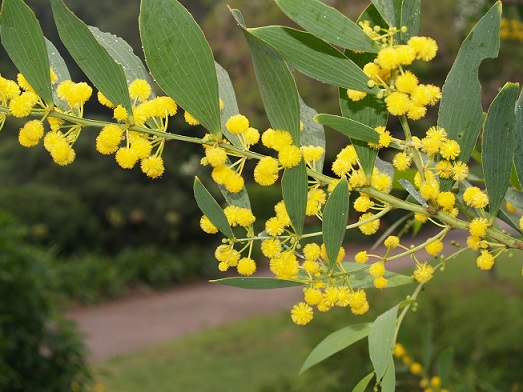Learn about Wattles!
Acacias occur naturally
mainly in dry tropical or mild temperate regions. Authorities vary on
the exact number of species that exist, but more are native to Australia
than anywhere else. Other species are as wide spread as Africa, America
and South East Asia. Some occur naturally in snow prone areas, and can
withstand very harsh winter conditions.
Being legumes, Acacias are useful for land rehabilitation, fast growing and able to contribute to improving soil fertility. They include commercially important plants grown for wood, producing gum arabic, and even edible seeds.
- Learn about the physiology, botany, culture, and propagation of Acacias.
- Learn about their nutritional and environmental requirements, as well as potential disease and pest issues.
- Learn
about the wide range of commercial uses for Acacias - the food
industry, in perfumes, medicine, furniture, as well as being used in
land rehabilitation projects.

COURSE STRUCTURE AND CONTENT
Course Duration: 100 hours.
Start Date: Start at any time - study at a pace that suits you, and with full tutor support for the duration of your studies.
Lessons: The course comprises 8 lessons as detailed, below.
1. Introduction and Resources
- Nature and Scope of Acacias.
- Plant/Acacia Taxonomy (classification and naming).
- Acacia Ecosystems.
- Significant Acacias from Australia, Africa and the Middle East.
2. Physiology and Botany of Acacias
- Acacia relatives; and the Order Fabales.
- Understanding flower structure of Acacias.
- An inflorescence.
- Using Botanical terms to describe Acacias.
- Acacia foliage.
- Classifying Acacias according to foliage type.
- Classifying Acacias according to flower type.
- Acacia fruits (seed pods).
3. Culture
- Environmental considerations.
- Nutrition.
- Pest and Disease.
- Soil conditions for Acacias.
- Typical cultural requirements.
- Australian Acacias (review of size, foliage and flowering).
- Weed management.
- Soil testing.
4. Propagation
- Scope of wattle propagation.
- Seed treatments.
- Sowing wattle seeds.
- Seed storage.
- Acacia cutting propagation.
- Transplanting seedlings or cuttings.
- Potting up.
5. Acacias And Their Uses
- As a landscape plant (windbreaks, screens, shrubberies, erosion control, soil enrichment, rock gardens, tubs).
- Plant selection.
- Buying the right specimen.
- Using Acacias as specimen trees.
- Garden Design with Acacias.
- Creating landscape affects.
- Acacia species for different conditions.
6. Other Uses For Acacias
- Timber.
- Tanning.
- Cut Flowers.
- Perfumery with Acacias.
- Acacias for human food.
- Acacias for animal fodder.
- Gum Arabic.
7. Pest & Disease of Acacias
- Nature and scope of Pest and Disease.
- Pest and Disease problems detected on Acacias.
- Environmental problems.
8. Special Project
- Problem Based Learning style project, to plan the establishment of a collection of Acacias for a specific location.
ACACIAS ARE A DIVERSE GROUP OF PLANTS
You may think that acacias are all short lived, super hardy, and come from similar places; but nothing could be further from the truth.
Some species are indigenous to very low rainfall areas, others come from high rainfall rain forests. Some are native to cold, snow prone climates, and others occur naturally in hot deserts closer to thew tropics. While some acacias are relatively short lived, there are others that can survive well over 100 years.
Learn about the Diversity of Acacias
As you progress through this course, you will deepen and broaden your understanding of many different species, learning to choose, nurture and use acacias more appropriately for different purposes in different places.
Acacias, like all plants obtain their food in the form of nutrients from the soil. There are around 50 different nutrients used by plants. Some are needed in large quantities (eg. Nitrogen, Potassium and Phosphorus), whilst others are only needed in small amounts.
- Different species of Acacia have different requirements.
- Nutrients must be in the right balance in the soil (ie. too much of one nutrient can stop another nutrient being used, even if it is there in an adequate quantity).
- Acacia baileyana, A.iteaphylla, A.obtusata, A.sauveolens, A.verticillata are known to be sensitive to too much phosphorus (They may suffer in high phosphorus soil, or if a strong phosphorus fertilizer is applied)
- If iron in the soil is in limited supply; the uptake of that iron can be impaired by high levels of phosphorus; the result being a yellowing of tip growth due to inadequate iron in the plant. The solution might not only to add iron, but also to avoid phosphorus.
- The acidity of the soil can affect the plant's ability to use nutrients; thus the acidity (or pH) must be at the right level for the plant to perform at it's best.
- Nodulation has been found to be sensitive to soil pH (eg. Research in Sudan showed certain arid species formed nodules better at a pH 6.5 to 7 and nodulation ceased at very low or very high temperatures
- Each type of plant has a different set of chemical conditions which are ideal for it (ie. what is best for one type of plant may not be best for another).
WHO CAN BENEFIT FROM THIS COURSE?
- Farmers
- Environmental Managers
- Horticulturists
- Foresters
- Gardeners, Landscapers, Nurserymen
- Students of botany
- Plant collectors or anyone else with a passion for this subject